
The Capitol Limited is a daily Amtrak train between Washington, D.C., and Chicago, running 764 miles (1,230 km) via Pittsburgh and Cleveland. Service began in 1981 and was named after the Baltimore and Ohio Railroad's Capitol Limited which ended in 1971 upon the formation of Amtrak. It carries the Amtrak train numbers 29 and 30, which were previously assigned to the discontinued National Limited.
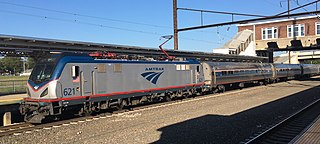
The Keystone Service is a 195 mile regional passenger train service from Amtrak, that operates between the Harrisburg Transportation Center in Harrisburg, Pennsylvania, and 30th Street Station in Philadelphia, running along the Philadelphia to Harrisburg Main Line. Most trains then continue along the Northeast Corridor (NEC) to Penn Station in New York City.

The Pennsylvanian is a 444-mile (715 km) daily daytime Amtrak train running between New York City and Pittsburgh via Philadelphia. The trains travel across the Appalachian Mountains, through Pennsylvania's capital Harrisburg, the Pennsylvania Dutch Country, suburban and central Philadelphia, and New Jersey en route to New York. The entire train ride takes about 9 hours total: 1.5 hours between New York and Philadelphia, 2 hours between Philadelphia and Harrisburg, and 5.5 hours between Harrisburg and Pittsburgh.

The Maryland Area Rail Commuter (MARC) is a commuter rail system in the Washington–Baltimore area. MARC is administered by the Maryland Transit Administration (MTA) and operated under contract by Alstom and Amtrak on track owned by CSX Transportation (CSXT) and Amtrak. In 2023, the system had a ridership of 3,860,600, or about 14,000 per weekday as of the second quarter of 2024, less than pre-COVID-19 pandemic weekday ridership of 40,000.

The Cardinal is a long-distance passenger train operated by Amtrak between New York Penn Station and Chicago Union Station via Philadelphia, Washington, D.C., Charlottesville, Charleston, Huntington, Cincinnati, and Indianapolis. Along with the Capitol Limited and Lake Shore Limited, it is one of three trains linking the Northeast and Chicago. The 1,146-mile (1,844 km) trip between New York and Chicago is scheduled for 281⁄4 hours.
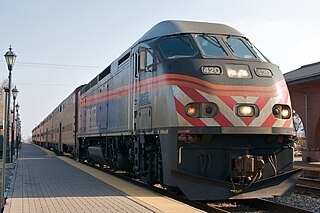
The Milwaukee District West Line (MD-W) is a Metra commuter rail line in Chicago, Illinois, and its western suburbs. Metra does not refer to any of its lines by a particular color, but the timetable accents for the Milwaukee District West line are dark "Arrow Yellow," honoring the Milwaukee Road's Arrow passenger train. Trains are dispatched from the Canadian Pacific Kansas City Railway's American headquarters in Minneapolis.

The Keystone Corridor is a 349-mile (562 km) railroad corridor between Philadelphia and Pittsburgh, Pennsylvania, that consists of two rail lines: Amtrak and SEPTA's Philadelphia-to-Harrisburg main line, which hosts SEPTA's Paoli/Thorndale Line commuter rail service, and Amtrak's Keystone Service and Pennsylvanian inter-city trains; and the Norfolk Southern Pittsburgh Line. The corridor was originally the Main Line of the Pennsylvania Railroad.

The Calumet, also commonly called the Valpo Local, was a 43.6-mile (70.2 km) passenger train route operated by Amtrak between Chicago and Valparaiso, Indiana. Despite Amtrak's mandate to provide only intercity service, the Calumet was a commuter train. Transferred from Conrail in 1979, the full route was shared with Amtrak's Broadway Limited until 1990; the Calumet was discontinued the next year.

A large metropolitan area that is surrounded by rivers and hills, Pittsburgh has an infrastructure system that has been built out over the years to include roads, tunnels, bridges, railroads, inclines, bike paths, and stairways; however, the hills and rivers still form many barriers to transportation within the city.

Greensburg station is an Amtrak railway station located approximately 30 miles (48 km) east of Pittsburgh at Harrison Avenue and Seton Hill Drive in Greensburg, Pennsylvania. The station is located just north of the city center. It is served only by Amtrak's Pennsylvanian, which operates once daily in each direction.

The Wolverine is a higher-speed passenger train service operated by Amtrak as part of its Michigan Services. The 304-mile (489 km) line provides three daily round-trips between Chicago and Pontiac, Michigan, via Ann Arbor and Detroit. It carries a heritage train name descended from the New York Central Railroad.

The Blue Water is a higher-speed passenger train service operated by Amtrak as part of its Michigan Services. The 319-mile (513 km) route runs from Chicago, Illinois, to Port Huron in Michigan's Blue Water Area, for which the train is named. Major stops are in Kalamazoo, Battle Creek, East Lansing, and Flint.

The Brunswick Line is a MARC commuter rail line between Washington, D.C., and Martinsburg, West Virginia, with a branch to Frederick, Maryland. It primarily serves the northern and western suburbs of Washington. The line, MARC's second longest at 74 miles, is operated under contract to MARC by Alstom and runs on CSX-owned track, including the Metropolitan, Old Main Line, and Cumberland subdivisions. It is the successor to commuter services provided by the Baltimore and Ohio Railroad (B&O), which date to the mid-19th century.

The Penn Line is a MARC passenger rail service operating between Union Station in Washington, D.C., and Perryville, Maryland, along the far southern leg of the Northeast Corridor; most trains terminate at Baltimore's Penn Station. It is MARC's only electrified line, though a majority of trains remain diesel powered. With trains operating at speeds of up to 125 miles per hour (201 km/h), it is the fastest commuter rail line in the United States. The service is operated by Amtrak under contract to the Maryland Transit Administration. MARC sets the schedules, owns most of the stations, and controls fares, while Amtrak owns and maintains the right-of-way, supplies employees to operate trains, and maintains the rolling stock. It is the busiest of MARC's three lines, with twice as many trains and riders as the Brunswick and Camden lines combined.
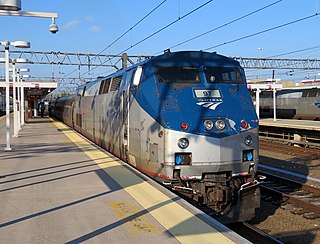
The Amtrak Hartford Line is a train service run by Amtrak primarily between Springfield, Massachusetts, and New Haven, Connecticut, along Amtrak's New Haven–Springfield Line.
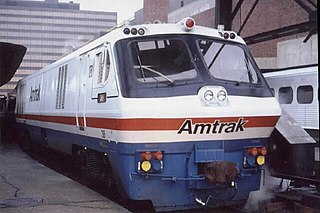
The Beacon Hill was a daily 157-mile (253 km) commuter rail service operated by Amtrak between Boston, Massachusetts, and New Haven, Connecticut, from 1978 to 1981. The Beacon Hill was one of the last long-haul commuter services operated by Amtrak. Service consisted of a single rush-hour round trip, with service eastbound to Boston in the morning and westbound to New Haven in the evening.

The Fort Pitt was a 117-mile (188 km) daily passenger train operated by Amtrak between Pittsburgh, Pennsylvania and Altoona, Pennsylvania. The Fort Pitt was a so-called Section 403(b) train, meaning that its operation was subsidized by the state of Pennsylvania.
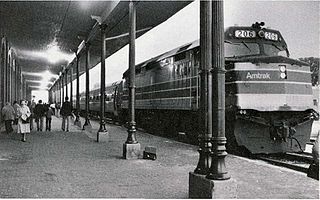
The Michigan Executive was a commuter train operated by Amtrak between Detroit, Michigan, and Jackson, Michigan. Amtrak took over the service from Penn Central in 1975 and discontinued it in 1984.

The Wilkinsburg station is a former passenger station build by the Pennsylvania Railroad and is located in Wilkinsburg, Pennsylvania, on Hay Street at the foot of Ross Avenue. The building was completed in 1916 when the railroad embankment through town was elevated above street level to eliminate hazardous grade crossings. The two previous stations had been located three blocks southeast along Wood Street between Franklin and Rebecca Avenues.

The PATrain, also known as Mon Valley Commuter Rail, was a commuter rail service owned by the Port Authority of Allegheny County in the Monongahela Valley in the US state of Pennsylvania. Service began in 1975 when the Port Authority assumed ownership of the Pittsburgh–McKeesport–Versailles commuter trains operated by the Baltimore and Ohio Railroad (B&O) with the support of PennDOT. The Port Authority discontinued the service in 1989.



















